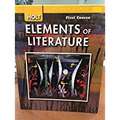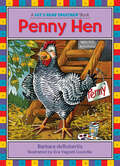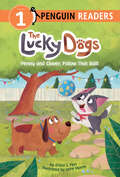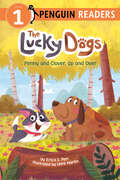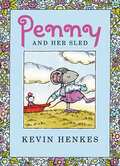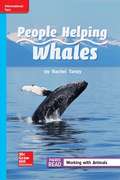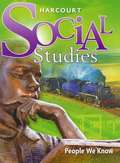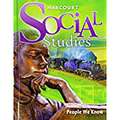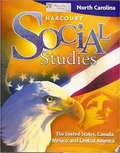- Table View
- List View
Pennsylvania Holt Elements of Literature®, Third Course
by Kylene Beers Lee OdellNIMAC-sourced textbook
Pennsylvania PSSA Coach Assessment Anchors: Reading, Grade 8
by Triumph LearningThis book, the PSSA Coach, Assessment Anchors, Reading, Grade 8, was written to help students sharpen their reading skills and prepare for the test in the following ways. The Coach consists of units that are divided into chapters and lessons, following the structure of the Pennsylvania Assessment Anchors and Standards. Every lesson focuses on teaching a single skill within an Anchor or Standard. After instructing on the Anchor or Standard, the lesson provides example questions. Each question is followed by a Quick Coach which helps students understand how to answer the question. Finally, the Test Practice section at the end of each chapter gives plenty of review and asks test-like questions to test what students have learned. Students work through the book carefully, remembering that the concept, or "big idea," behind an answer is more important than the answer itself. There are no shortcuts to doing well on the PSSA test. Students should study hard and let the PSSA Coach, Assessment Anchors, Reading, Grade 8, guide them to success.
Pennsylvania, Our Home
by Susan DonleyPennsylvania, Our Home is a 4th grade Pennsylvania history textbook. The outline for this book is based on the Pennsylvania Academic Standards for History and teaches geography, geology, history, economics, citizenship, and government.
Pennsylvania: A History Of The Commonwealth
by Randall M. Miller William A. PencakThe Keystone State, so nicknamed because it was geographically situated in the middle of the thirteen original colonies and played a crucial role in the founding of the United States, has remained at the heart of American history. Created partly as a safe haven for people from all walks of life, Pennsylvania is today the home of diverse cultures, religions, ethnic groups, social classes, and occupations. Many ideas, institutions, and interests that were first formed or tested in Pennsylvania spread across America and beyond, and continue to inform American culture, society, and politics. This book tells that story--and more. It recenters Pennsylvania in the American historical narrative. <p><p> Pennsylvania: A History of the Commonwealth offers fresh perspectives on the Keystone State from an array of distinguished scholars who view the history of this Commonwealth critically and honestly, using the latest and best scholarship to give a modern account of Pennsylvania's past. They do so by emphasizing the evolution of Pennsylvania as a place and an idea. The book, the first comprehensive history of Pennsylvania in almost three decades, sets the Pennsylvania story in the larger context of national social, cultural, economic, and political development. Without sacrificing treatment of the influential leaders who made Pennsylvania history, the book focuses especially on the lives of everyday people over the centuries. It also magnifies historical events by examining the experiences of local communities throughout the state.
Pennsylvania: Adventures in Time and Place
by James A. Banks Walter C. Parker Gloria Ladson-Billings Barry K. Beyer Gloria Contreras Jean Craven Mary A. McfarlandPennsylvania Adventures in Time and Place has eleven chapters. Each chapter has two or more lessons. There are also many special features for you to study and enjoy.
Pennsylvania: Our People, Places, and Past
by Randall A. PellowThis book presents the rich history, geography, people and products of the state of Pennsylvania.
Penny Hen: Short Vowel E (Let's Read Together ®)
by Barbara deRubertisLet&’s Read Together books merge rhyme and vowel sounds in delightfully zany stories kids will want to read again and again. Each of the 15 books in this classic series by award-winning author/educator Barbara deRubertis will give your child a jumpstart on reading success."Story lines are silly and inventive, and recall Dr. Seuss&’s Cat in the Hat for the building of rhythm and rhyming words." —School Library JournalPenny Hen is a bit upset when she learns she won't be Jenny's only pet! (This easy-to-read story features the short &“e&” vowel sound.)
Penny and Clover, Follow That Ball! (The Lucky Dogs)
by Erica S. PerlLearning to read doesn't need to be ruff with this rhyming tail about a pair of lovable pups, now with a fresh look!Penny and Clover are playing with a ball. They chase it as it bounces all over their backyard, bounding in every direction. But when they go to retrieve it once more, they're surprised to find a new friend at the same time!
Penny and Clover, Up and Over (The Lucky Dogs)
by Erica S. PerlLearning to read doesn't need to be ruff with this rhyming tail about a pair of lovable pups, now with a fresh look!Penny is a small, frisky puppy. Clover is a big, careful canine. While Penny has no problem jumping over a log, Clover isn't so sure she can do it. Can Clover come up with the courage to take a leap of faith and follow her friend?
Penny and Her Sled (I Can Read Book: Level 1 Ser.)
by Kevin Henkes“A gentle story of patience.”—Horn Book (starred review)Caldecott Medal–winner Kevin Henkes’s award-winning and bestselling mouse, Penny, stars in an irresistible story about anticipation, disappointment, and a brand-new sled. Told in five short chapters, Penny and Her Sled is perfect for reading alone, reading aloud, and sharing together.When Penny, a sweet and curious mouse, gets a new sled, she can’t wait to use it. But there’s one big problem—there’s no snow!Patiently, Penny waits and watches for the snow to appear. She puts on her scarf and hat. She sleeps with her mittens. Maybe if she’s ready, the snow will finally come. But day after day, the snow does not arrive. Finally, Penny decides she will use her sled for other things—it’s too wonderful not to!With a little imagination, the sled becomes a bridge for her glass animals to cross. It becomes a bed for her doll, Rose. It becomes a magic carpet that takes Penny and Rose on adventures all around the world.And as Penny waits for a snowfall that may never appear, she learns all about the power of patience, imagination, play . . . and spring! Told in five short chapters, and with an emphasis on family and patience, Penny and Her Sled is the perfect choice for emergent readers and for family sharing.
Pensar con modelos matemáticos: Variación lineal e inversa
by Glenda Lappan James T. Fey Susan N. Friel Elizabeth Difanis PhillipsNIMAC-sourced textbook
Pension Compilation
by Muthuswamy BrindaThe provisions relating to pension and gratuity including family pension, which were spread over the Civil Service Regulations and various executive instructions, were codified in 1972, in the form of statutory rules — The CCS (Pension) Rules, 1972. Since the promulgation of these rules, there have been successive liberalization of the substantive provisions contained therein, with consequent scores of amendments as also complete replacement of chapters relating to procedure for processing and finalizing pension cases. As per notification, dated 30-12-2003 of the Government, these rules are applicable only to those who are appointed on or before the 31st December, 2003.
People Helping People: After Hurricane Katrina [Approaching Level, Grade 2]
by Barbara KanninenNIMAC-sourced textbook
People Helping People: After Hurricane Katrina [Beyond Level, Grade 2]
by Barbara KanninenNIMAC-sourced textbook
People Helping People: After Hurricane Katrina [On Level, Grade 2]
by Barbara KanninenNIMAC-sourced textbook
People Who Make a Difference
by Michael J. Berson Tyrone C. Howard Cinthia SalinasNIMAC-sourced textbook
